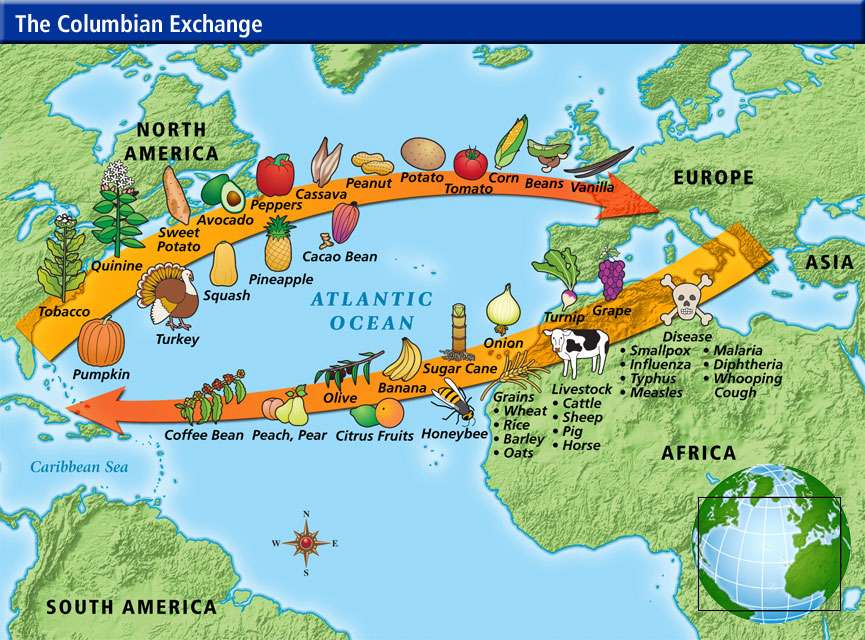August 18
by Thunder Student Olivia H.
 The categories listed above are very general. Many more things were included within each of those groups. For example, Europe brought smallpox, measles, chicken pox, malaria, yellow fever, influenza, and the common cold to the Americas, all of which were quite fatal. On the other hand, the only disease Americans gave to Europeans was syphilis, which was manageable. The Europeans also introduced many new animals and plants to the American natives, including: horses, cattle, pigs, sheep, goats, and chickens, as well as rice, wheat, barley, oats, coffee, sugarcane, bananas, melons, olives, dandelions, daisies, clover, ragweed, and Kentucky bluegrass. And to the Europeans, Americans showed: turkeys, llamas, alpacas, and guinea pigs, as well as corn, potatoes, beans, tobacco, peanuts, squash, peppers, tomatoes, pumpkins, pineapples, cacao/cocoa, chicle (the source of chewing gum), papayas, manioc/tapioca, guavas, and avocados.
The categories listed above are very general. Many more things were included within each of those groups. For example, Europe brought smallpox, measles, chicken pox, malaria, yellow fever, influenza, and the common cold to the Americas, all of which were quite fatal. On the other hand, the only disease Americans gave to Europeans was syphilis, which was manageable. The Europeans also introduced many new animals and plants to the American natives, including: horses, cattle, pigs, sheep, goats, and chickens, as well as rice, wheat, barley, oats, coffee, sugarcane, bananas, melons, olives, dandelions, daisies, clover, ragweed, and Kentucky bluegrass. And to the Europeans, Americans showed: turkeys, llamas, alpacas, and guinea pigs, as well as corn, potatoes, beans, tobacco, peanuts, squash, peppers, tomatoes, pumpkins, pineapples, cacao/cocoa, chicle (the source of chewing gum), papayas, manioc/tapioca, guavas, and avocados.
Overall, the Columbian Exchange proved to be mostly useful, as it provided both hemispheres with goods that they’d never before seen or heard of, and therefore could use for improvement. However, it wasn’t all good, because many Americans did die due to all of the diseases they received and were unable to cure. But, we’ll just say that it was mostly good, because all of the countries involved are still bustling with people and are much more improved than they would’ve been if this exchange hadn’t taken place.
by Thunder Student Olivia H.
Yesterday in history, we discussed the Columbian Exchange. Basically, the Columbian Exchange was a large global trade between the Eastern and Western hemispheres. Everything was traded: goods, ideas, people, and diseases. On a side note, the exchange was named for the explorer, Christopher Columbus, who is given more credit than he really deserves. (The exchange began with his voyages, but he wasn't a nice guy.)
 The categories listed above are very general. Many more things were included within each of those groups. For example, Europe brought smallpox, measles, chicken pox, malaria, yellow fever, influenza, and the common cold to the Americas, all of which were quite fatal. On the other hand, the only disease Americans gave to Europeans was syphilis, which was manageable. The Europeans also introduced many new animals and plants to the American natives, including: horses, cattle, pigs, sheep, goats, and chickens, as well as rice, wheat, barley, oats, coffee, sugarcane, bananas, melons, olives, dandelions, daisies, clover, ragweed, and Kentucky bluegrass. And to the Europeans, Americans showed: turkeys, llamas, alpacas, and guinea pigs, as well as corn, potatoes, beans, tobacco, peanuts, squash, peppers, tomatoes, pumpkins, pineapples, cacao/cocoa, chicle (the source of chewing gum), papayas, manioc/tapioca, guavas, and avocados.
The categories listed above are very general. Many more things were included within each of those groups. For example, Europe brought smallpox, measles, chicken pox, malaria, yellow fever, influenza, and the common cold to the Americas, all of which were quite fatal. On the other hand, the only disease Americans gave to Europeans was syphilis, which was manageable. The Europeans also introduced many new animals and plants to the American natives, including: horses, cattle, pigs, sheep, goats, and chickens, as well as rice, wheat, barley, oats, coffee, sugarcane, bananas, melons, olives, dandelions, daisies, clover, ragweed, and Kentucky bluegrass. And to the Europeans, Americans showed: turkeys, llamas, alpacas, and guinea pigs, as well as corn, potatoes, beans, tobacco, peanuts, squash, peppers, tomatoes, pumpkins, pineapples, cacao/cocoa, chicle (the source of chewing gum), papayas, manioc/tapioca, guavas, and avocados. Overall, the Columbian Exchange proved to be mostly useful, as it provided both hemispheres with goods that they’d never before seen or heard of, and therefore could use for improvement. However, it wasn’t all good, because many Americans did die due to all of the diseases they received and were unable to cure. But, we’ll just say that it was mostly good, because all of the countries involved are still bustling with people and are much more improved than they would’ve been if this exchange hadn’t taken place.
No comments:
Post a Comment